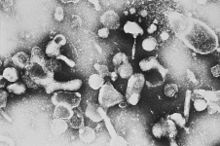Feline leukemia virus
| Feline leukemia virus | |
|---|---|
 |
|
| Electron micrograph of Feline leukemia virus | |
| Virus classification | |
| Group: | Group VI (ssRNA-RT) |
| Order: | Unassigned |
| Family: | Retroviridae |
| Subfamily: | Orthoretrovirinae |
| Genus: | Gammaretrovirus |
| Species: | Feline leukemia virus |
Feline leukemia virus (FeLV) is a retrovirus that infects cats. FeLV can be transmitted from infected cats when the transfer of saliva or nasal secretions is involved. If not defeated by the animal’s immune system, the virus can cause diseases which can be lethal. One disease caused by this virus is a form of cancer of the blood cells called Lymphoma.
The signs and symptoms of infection with feline leukemia virus are quite varied and include loss of appetite, poor coat condition, anisocoria (uneven pupils), infections of the skin, bladder and respiratory tract, oral disease, seizures, lymphadenopathy (swollen lymph nodes), skin lesions, fatigue, fever, weight loss, stomatitis, gingivitis, litter box avoidance, pancytopenia, recurring bacterial and viral illnesses, anemia, diarrhea and jaundice.
Asymptomatic carriers will show no signs of disease, often for many years.
The disease has a wide range of effects. The cat can fight off the infection and become totally immune, can become a healthy carrier that never gets sick itself but can infect other cats, or a mid-level case in which the cat has a compromised immune system. Nevertheless, the development of lymphomas is considered the final stage of the disease. Although it is thought that virus protein has to be present to induce lymphomas in cats, newer evidence shows that a high percentage of FeLV-Antigen negative lymphomas contain FeLV-DNA, indicating a "hit-and-run" mechanism of virus-induced tumor development.
Once the virus has entered the cat, there are six stages to a FeLV infection:
If the cat's immune system does not fight off the virus, then it progresses to:
...
Wikipedia
